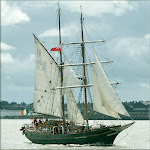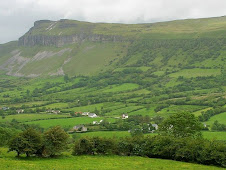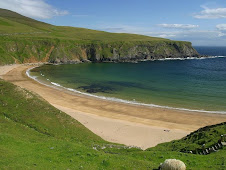 One has not to be a sailor or tall ships enthusiast to know the name Cutty Sark. This world-famous former British tea clipper - and the last existing ship of its type - has entered the realm of general knowledge a long time ago.
One has not to be a sailor or tall ships enthusiast to know the name Cutty Sark. This world-famous former British tea clipper - and the last existing ship of its type - has entered the realm of general knowledge a long time ago.Built in 1869 in Dumbarton/Scotland and commissioned in February 1870, she was constructed as a fast three-master for the China tea trade. This trade was at the time intensely competitive and involved a race across the globe from China to London, with immense profits to the ship that arrived with the first tea of the year.
 In the most famous race, against the Thermopylae in 1872, both ships left Shanghai together on June 18th, but two weeks later Cutty Sark lost her rudder after passing through the Sunda Strait. She arrived in London on October 18th, a week after Thermopylae, with a total passage time of 122 days. Her legendary reputation comes from the fact that her captain chose to carry on with an improvised rudder instead of putting into a port for a replacement. And though she was seriously disadvantaged, she was only beaten by one week.
In the most famous race, against the Thermopylae in 1872, both ships left Shanghai together on June 18th, but two weeks later Cutty Sark lost her rudder after passing through the Sunda Strait. She arrived in London on October 18th, a week after Thermopylae, with a total passage time of 122 days. Her legendary reputation comes from the fact that her captain chose to carry on with an improvised rudder instead of putting into a port for a replacement. And though she was seriously disadvantaged, she was only beaten by one week.Later the ship had a mixed history, carrying wool from Australia to Britain and sailing for some years for a Portuguese owner. Under the respected Captain Richard Woodget she did very well, posting Australia-to-Britain times of as little as 67 days. Her best run, 360 nautical miles (666 km) in 24 hours (an average of 15 kn or 28 km/h), was said to have been the fastest of any ship of her size. In 1916 she was dismasted off the Cape of Good Hope, sold, re-rigged in Cape Town as a barquentine, and re-named Maria do Amparo.
Then - in 1922 - she was bought by Captain Wilfred Dowman, who restored her to her original appearance as a three-masted fully-rigged ship and used her as a stationary training ship. In 1954 she was moved to a custom-built dry-dock at Greenwich and has been there ever since as a museum ship and tourist attraction. Hundreds of thousands of people from all over the world have visited her and admired her exceptional beauty.
 Unfortunately this great ambassador from the past was almost destroyed in a fire last year. On the morning of May 21st, 2007 the Cutty Sark, which had been closed and partly dismantled for substantial conservation work, caught fire and burned for several hours before the London Fire Brigade could bring the blaze under control. Initial reports indicated that the damage was extensive, with most of the wooden structure in the centre having been lost.
Unfortunately this great ambassador from the past was almost destroyed in a fire last year. On the morning of May 21st, 2007 the Cutty Sark, which had been closed and partly dismantled for substantial conservation work, caught fire and burned for several hours before the London Fire Brigade could bring the blaze under control. Initial reports indicated that the damage was extensive, with most of the wooden structure in the centre having been lost.Richard Doughty, chief executive of the Cutty Sark Trust, revealed the next day that at least half of the "fabric" (timbers, etc.) of the ship had not been on site, as it had been removed during the preservation work. The trust was most worried about the state of iron framework to which the fabric was attached. But at least the ship was not lost after all and could be restored again, although at the price of an additional £ 10 million, which brought the total costs of the ship's restoration to about £ 35 million.
Fortunately the project received a substantial financial boost by winning the 'Museum of the Year' award, and many donations - large and small - came in from private individuals. This included school children who gave £ 1 of their pocket money, and the Israeli shipping magnate Sammy Ofer, who donated £ 3.3 million. A further £ 10 million came from the British Heritage Lottery Fund and the full restoration of the Cutty Sark is now secured. Work is expected to be complete by 2010.
For more than a year the cause of the fire was not clearly established. After initial analysis of CCTV footage from the area suggested the possibility of arson, further investigation over the following days by Scotland Yard failed to find conclusive proof that the fire was set deliberately.
After a long forensic investigation it has now been established that the devastating fire was not caused by human hands directly, but by an overheated industrial vacuum cleaner, which was used by foreign contractors to remove waste from the ship as part of the renovation work.
The vacuum cleaner was left switched on for two days over the weekend, overheated and then caused an electrical fire.
Police said the vacuum cleaner did not have a vital cut-off switch that prevents overheating, because it had been adapted for a lower UK power voltage.
Detective Chief Inspector Dave Garwood, who led the inquiry, said that two private 'security guards' on duty at the site failed to spot the fire in its early stages. They could have reported it sooner and a fire marshal inspection before the weekend could also have helped to prevent it.
The two men, who had been dismissed after the incident, were - according to DCI Garwood - "vague and inconsistent" witnesses.
He also said that (mostly foreign) renovation workmen were responsible for dangerous practices onboard, including electrical equipment often left plugged in, debris not removed immediately and loose electrical connections.
It was also not clear if fire alarm tests were completed properly in the weeks before the blaze.
All this shows once again how dangerous - and in the end for more costly - the modern business practice of cost-cutting, employing cheaper foreign workers and 'out-sourcing' of specialist work to contractors can be. Had the restoration work been done by a dedicated team of UK experts, the wage bill would certainly have been higher, but the devastating fire would most likely never have happened.
The now revealed details of the incident also prove that the use of private 'security guards' does not guarantee or enhance security. Quite the opposite is often the case, as most of these so-called 'guards' have little education, almost no training and usually no experience in the security field. It is evident that the old phrase still stands: If you pay peanuts, you will only get monkeys.
However, the good news after all the trauma and devastation is that in two years' time the Cutty Sark will be on display again, probably more beautiful than ever. And that will be appreciated by many, including
The Emerald Islander







































4 comments:
Typical.....happens here all the time.
I was so mad last year when I was in London visiting my husbands family and we went to go on the Eye and couldn't see the Cutty because it was still being "fixed". Big bummer.
Well, it is a real shame. And every day the Cutty Sark is not on display and open to the public, the Trust and London tourism are losing money.
It is really unbelievable that they employed the cheapest unskilled workmen from abroad on such a prestigious project. These days it is all about 'outsourcing' to the lowest bidder, and not about who is best qualified and can the job do well.
The contractors from abroad even had to bring their own tools. Hence the vacuum cleaner that had to be adapted to the different UK voltage level, then was left switched-on for two days without supervision, overheated and caught fire.
But even then it could have been a mere little accident, had the two 'security guards' done the job they were paid for and not slept on duty. Private 'security guards' are one of the major reason for the rising level of insecurity in the modern society of the western world.
Yes! It was unfortunate. But it could have been avoided..
Hello Everybody,
My name is Mrs Sharon Sim. I live in Singapore and i am a happy woman today? and i told my self that any lender that rescue my family from our poor situation, i will refer any person that is looking for loan to him, he gave me happiness to me and my family, i was in need of a loan of S$250,000.00 to start my life all over as i am a single mother with 3 kids I met this honest and GOD fearing man loan lender that help me with a loan of S$250,000.00 SG. Dollar, he is a GOD fearing man, if you are in need of loan and you will pay back the loan please contact him tell him that is Mrs Sharon, that refer you to him. contact Dr Purva Pius,via email:(urgentloan22@gmail.com) Thank you.
BORROWERS APPLICATION DETAILS
1. Name Of Applicant in Full:……..
2. Telephone Numbers:……….
3. Address and Location:…….
4. Amount in request………..
5. Repayment Period:………..
6. Purpose Of Loan………….
7. country…………………
8. phone…………………..
9. occupation………………
10.age/sex…………………
11.Monthly Income…………..
12.Email……………..
Regards.
Managements
Email Kindly Contact: urgentloan22@gmail.com
Post a Comment